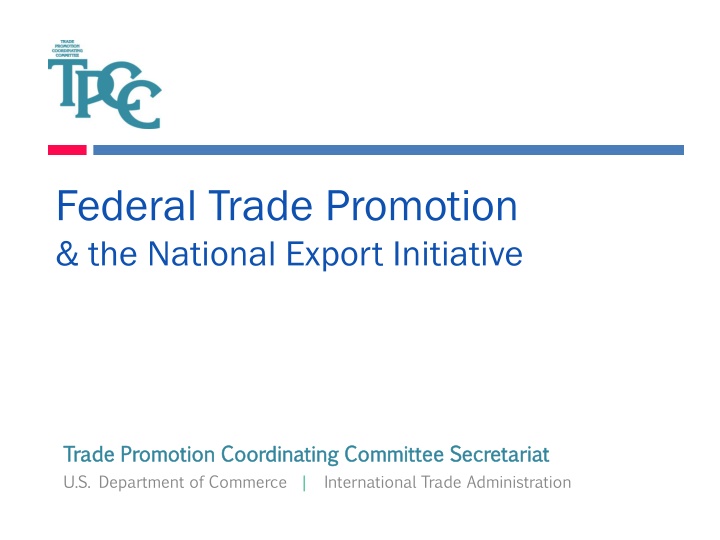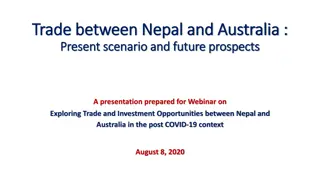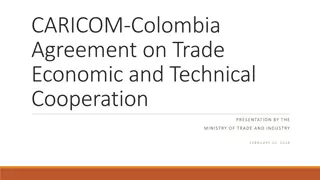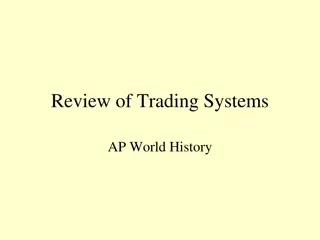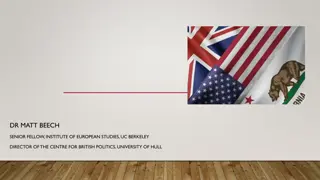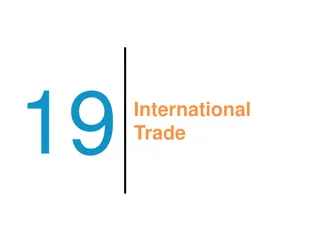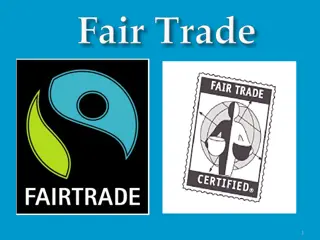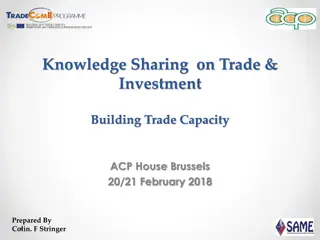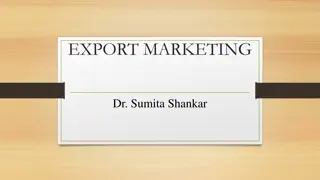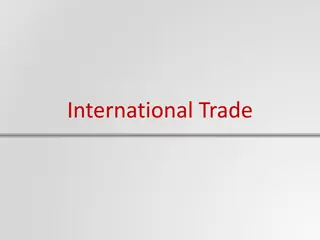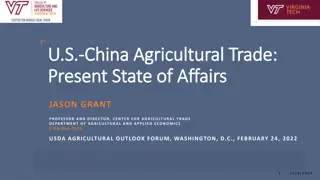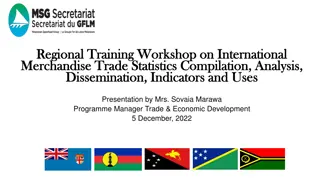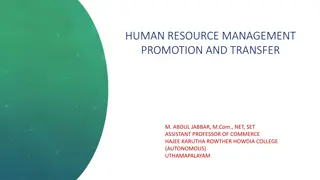U.S. Trade Promotion Initiatives Overview
The imperative to go global and challenges faced by U.S. companies in export, factors driving the need to export, challenges in increasing exports, and the importance of trade assistance with a focus on Trade Promotion Coordinating Committee activities.
Download Presentation

Please find below an Image/Link to download the presentation.
The content on the website is provided AS IS for your information and personal use only. It may not be sold, licensed, or shared on other websites without obtaining consent from the author.If you encounter any issues during the download, it is possible that the publisher has removed the file from their server.
You are allowed to download the files provided on this website for personal or commercial use, subject to the condition that they are used lawfully. All files are the property of their respective owners.
The content on the website is provided AS IS for your information and personal use only. It may not be sold, licensed, or shared on other websites without obtaining consent from the author.
E N D
Presentation Transcript
Federal Trade Promotion & the National Export Initiative Trade Promotion Coordinating Committee Secretariat Trade Promotion Coordinating Committee Secretariat U.S. Department of Commerce | International Trade Administration
Overview The imperative to go global and challenges U.S. companies face Federal trade promotion coordination The National Export Initiative and NEI/NEXT
The international imperative Online sales and e-commerce platforms Global middle class growth U.S. trade agreements and policies unlocking new opportunities worldwide
Why export? Why support exporters? Firm-level perspectives: U.S. goods and services are in high demand the gold standard of innovation, quality, and safety More than 95% of the world s consumers live outside of the United States More than 80% of the world s purchasing power is located outside of the United States Policymaking and program perspectives: Exporters are more competitive They can pay wages 13-18% higher than other firms They are 8.5% less likely to go out of business Smaller firms are more resource-constrained than larger companies, particularly when it comes to international expansion.
Challenges to increasing U.S. exports & number of exporting companies Slow growth worldwide Less than 5 percent of U.S. companies export. Price fluctuations, particularly with commodities Most U.S. businesses are unaware trade assistance exists, much less from the U.S. government Many businesses do not know where to start the process seems too complicated More than half of those sell to only ONE market. Fear of the unknown Emergence of regulatory and standards- based barriers in overseas markets New issues in digital trade
Trade assistance is increasingly important Clients are highly likely to recommend U.S. gov t assistance Marketing & planning assistance (including meeting foreign buyers and partners) Export Mechanics & Compliance Commercial Diplomacy Export Financing Products U.S. businesses use our services to: Increase or retain sales Export to a new market Overcome a barrier to trade
Trade Promotion Coordination Trade Trade Promotion Coordinating Committee (TPCC Promotion Coordinating Committee (TPCC): ): Interagency task force established by law in 1992 and chaired by the Secretary of Commerce Purpose: Establish whole-of-government priorities Coordinate trade agencies Make it easier for customers to navigate federal programs & the export process Responsible for issuing annual National Export Strategy Mechanisms: Foreign Commercial Service, Export Assistance Centers, Advocacy, Trade Compliance, export.gov, SelectUSA Export Promotion Cabinet: Cabinet-level group established by Executive Order in 2010 Chaired by President/Deputy National Security Advisor Purpose: Oversee progress on National Export Initiative
Federal Trade Agencies (TPCC Members) Oversight TPCC Principals/EPC Secretary of Commerce/Deputy National Security Advisor National Security Council Office of Management and Budget TPCC Deputies Council of Economic Advisors International Trade Administration Under Secretary Policy-focused: Export Service/Finance: Sector/Issue-Based: U.S. Trade Representative Commerce/ International Trade Administration Defense Commerce/ International Trade Administration Energy Transportation State Labor Treasury Small Business Administration Homeland Security State Agriculture Interior U.S. Export-Import Bank U.S. Agency for International Development (USAID) Trade and Development Agency (USTDA) TPCC Working Groups Agency staff-led Environmental Protection Agency (EPA) Overseas Private Investment Corporation (OPIC)
Core Trade Promotion Agencies Commerce: Commerce: Market research, market entry and matchmaking, major project advocacy, market access and compliance U.S. and overseas field. State: State: Commercial advocacy, commercial function in many posts, trade promotion initiatives (e.g., Directline, BIDs). SBA: SBA: Working capital, export express and trade loans, business counseling. EXIM: EXIM: Export loan guarantees, export credit insurance, and direct loans to foreign buyers, state and local partnerships. OPIC: OPIC: U.S. investment & know-how in emerging economies: guarantees, project finance, political risk insurance. US Trade and Development Agency: US Trade and Development Agency: Reverse trade missions, feasibility studies, conferences, state and local partnerships. Agriculture: Agriculture: Services, grants, and financing. Delivered through associations and state regional groups. USTR: USTR: Trade negotiations and trade agenda outreach. Growing small business agenda.
How the TPCC functions Secretariat (more on next slide Principals/Deputies TPCC Staff Representatives Sub-groups (not all currently active): Small Business Environment; Renewable Energy; Civil Nuclear Brazil, India, Africa, Look South /Latin America
The role of the TPCC Secretariat Gathers qualitative and quantitative analysis on U.S. exporting companies and potential exporters, challenges, and opportunities, AND: Develops a national export strategy Serves as a mechanism for executing Administration-wide export initiatives, most recently NEI/NEXT facilitates information sharing and serves as a collaboration platform Incubates new export promotion initiatives (e.g. Doing Business in Africa, Startup Global) Makes recommendations for improving export promotion program and policies Informs partnerships and relationships with major multipliers Serves as the primary source for information on gov t-wide export programs
National Export Strategy Through NEI/NEXT, federal agencies are advancing program and policy improvements to: 1. 2. Provide exporters more tailored assistance and information; Streamline export reporting requirements and improve the performance of the national freight network; Expand access to export financing; Partner at the state and local level to support export and foreign direct investment attraction strategies; and Ensure market access and a level playing field. 3. 4. 5. These efforts will enable more U.S. businesses to capitalize on existing and potential opportunities created by free trade agreements and the U.S. trade agenda
NEI/NEXT Aligned Initiatives Objective Key Strategies Aligned Initiatives and Programs ITA Customer Survey | Salesforce CRM common customer service platform Provide more tailored and focused export assistance #1: Connect more U.S. businesses to their nextglobal customer New services development/refining services Initial Market Check | Trade Promotion Programs Top Markets Reports - internal & external | Infrastructure Pilot | Industry Forward field alignment Doing Business in Africa | Look South | TPP market promotion| U.S.-EU SMEs| Discover Global Markets outreach events Made in Rural America | Women-owned biz partners | MOU with MBDA | Startup Pilot | Veterans Supply actionable information to U.S. businesses Internal/external knowledge mgmt strategy | Data acquisition plan development Data Services Platform| Market Selection Tool & Tariff Tool | Country Commercial Guides Strategic Partnerships | Industry Advisors E-commerce innovation lab Support companies in emerging U.S. industries Top Markets Reports in emerging industries Educate and partner with local and regional leaders to promote exports and inward FDI Best practices research (innovations in export promotion; coordination) #4: Promote exports and FDI attraction as the next economic development priority for communities Building partnerships with economic development associations (IEDC, NGA, NACo, etc.) | Coordinating EDO outreach with SelectUSA and TPCC agencies Provide support to states and metro areas to expand export activity and attract FDI EDA Grants | Technical Assistance (e.g. TPCC training) | EDO toolkits | MDCP Ecosystem leadership (e.g. serving on Brookings/Global Cities steering committees) | Support for planning and implementation of local export/FDI strategies | Addressing gaps in export assistance interagency coordination (e.g. 2012 Communique) | Strengthening federal-state-local) coordination (e.g. STEP, joint strategic planning, new TPCC working group)
Thank you Trade Promotion Coordinating Committee Secretariat Trade Promotion Coordinating Committee Secretariat Pat.Kirwan@trade.gov | 202-482-5455
